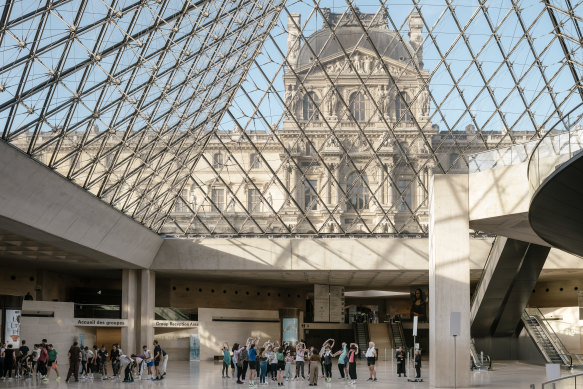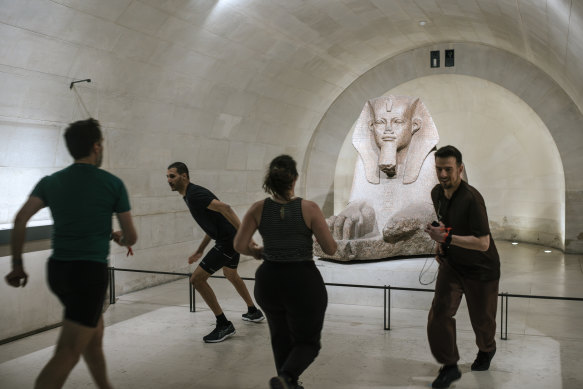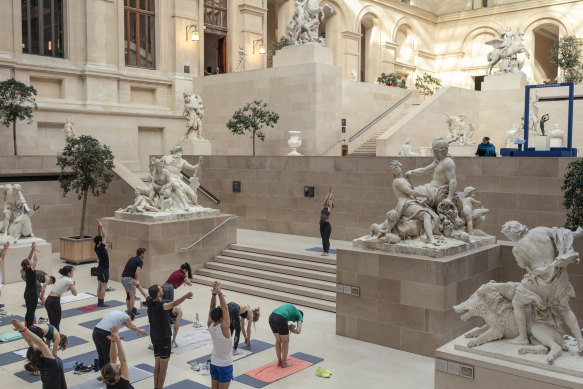
“It’s not the spirit looking,” he explained. “It’s the body.”
He offered Mehdi Kerkouche, a local choreographer, a tour with curators and gave him carte blanche to design the sessions – with one small request.
“Forget the Mona Lisa, for once,” Bouniol-Laffont said. “There are so many other things to see.”

Some nine million people crowd the halls of the Louvre each year, and a few are grabbing a chance to have it to themselves.Credit: Dmitry Kostyukov/The New York Times
The classes, priced at €38, about $62, for adults, sold out within an hour of going online. They last to the end of this month.
The biggest draw is the timing. The dancing begins an hour before the museum opens. Each morning, some 60 lucky people – divided into two groups of 30 – get to experience a private viewing normally enjoyed only by the likes of Beyoncé and Jay-Z.
No giant lines, no pressing crowds, no selfie sticks: we had the Louvre to ourselves.
While the French are passionate gallery-goers, they aren’t hugely into the Louvre. Some 9 million people crowd its halls each year, but the vast majority aren’t French. The place is just too big and crowded. The experience of viewing the Mona Lisa is similar to squeezing into the subway at rush hour; some 30,000 people press before it each day. Why suffer through that when there are more than 100 less-packed museums, full of marvelous things, scattered around the city?
Even Kerkouche admitted he hadn’t been inside the building since he was a child. “All the Parisians are the same,” he said. “I bike every day in front of it to go from one place to another in the city. But I just don’t look at it any more.”
Arriving at the Louvre alone, before the crowds, gave me the space to really look at it. And boy, is it breathtaking?
In the centre of the outer courtyard, I.M. Pei’s glass pyramid glowed purple-blue in the morning light. I stepped inside it and floated down the escalator into the museum’s modern foyer, the reflection of the building’s ornate stone facades, with its columns and statues, scattered around me.
I felt like a character in a Disney cartoon. It was magical.
Kerkouche’s idea was to have a four-part session, in four different rooms, tucked close to one another in two of the Louvre’s three wings. Otherwise, he said, the hour would be eaten up by commuting.
He asked four collaborators – three dancers and his gym coach – to help design a 15-minute class for each space. Each one was inspired, energetically, by the room.
Disco dancing in the Salle des Cariatides, which once had held royal balls, was obvious; to him, disco was the modern version of ballroom dancing. “We have to give back the first purpose of this room,” he said.
From there, my group stepped into the next room for some quick stretching beside the Venus de Milo and then ran down to the basement to the oldest part of the building for warrior training – lunges, squats and jumping jacks to the beats of AC/DC’s Highway to Hell.
It befit the Louvre’s origins as a fortress built around 1200 to protect the medieval city from the Normans while King Philippe Auguste was on a crusade. Over the centuries, it was converted into a royal palace and greatly expanded. In 1984, while doing a huge renovation of the building, archaeologists unearthed the base of the original rough limestone walls.

An exercise class, held before crowds arrive, in The Louvre Museum in Paris.Credit: Dmitry Kostyukov/The New York Times
We did running races up and down the steps towards the Great Sphinx of Tanis, which guards the entrance to the Egyptian antiquities collection. I imagined its pouting lips smiling just slightly and its huge stone tail flicking in mild feline amusement.
We whooped and hollered as we ran up the stairwell to the next class, the echoes washing over my body. The instructors played hide-and-seek during their first walk-through together, I was told. They maintained that sense of playfulness.
It was all so otherworldly and silly. I felt the sense of exhilaration and freedom I remember from summer camp when I was a kid.
Loading
We were instructed to dance into our next class, through a tunnel made of the massive bodies of two stone bulls with eagle wings and the heads of bearded men. Inside, we were greeted by a reconstructed 2700-year-old courtyard of Khorsabad, a palace of King Sargon II, leader of the Assyrian empire. Abandoned soon after his death, the palace was unearthed in 1843 in modern-day Iraq by the French vice consul to Mosul. Parts were sent to the Louvre soon after for display.
The giant statues inspired Kerkouche to offer a class in dancehall, the Jamaican urban dance in which moves are rooted, powerful and sensual.
“We are living statues,” said Queensy Blazin’, the dance instructor who led us through rounds of twerking, stomping while scooping our arms and bouncing forward into squats while barking “ha” to the deep beats of Sean Paul’s Get Busy.
The joy was infectious and irresistible.
Even the security guard was dancing at her post. She had never seen anything like it in her 34 years working here, she confided.
Beauty shouldn’t just be stared at, I realised. It should be enjoyed and celebrated.
Our last stop was in the part of the Louvre that was once a carpark for the Ministry of Finance, which, for more than a century, had its offices in one wing of the building. In 1984, the space was converted into a peaceful courtyard with potted trees, benches and Carrara marble statues from the royal gardens of the Marly palace. That was a former getaway spot for Louis XIV, where he’d come to relax in the stunning gardens, resplendent with waterfalls, groves and pools.
And so there we did yoga. The teacher led us through downward dogs and pigeon poses before giant statues of rearing horses and hunters – a homage to the king’s favourite pastimes.
I noticed seagulls wheeling above the giant glass roof.
“Normally, yoga is very introspective,” Laure Dary, the instructor, explained to me later. “But this is a setting like no other. I have to tell them to open their eyes.”

A yoga class, held before crowds arrive, in the Louvre Museum in Paris.Credit: Dmitry Kostyukov/The New York Times
She directed us to focus on one statue and take it as a mental memento. I gazed into the stone eye of a marble boar being speared by a hunter in a tunic.
At the end, my fellow rosy-cheeked participants crowded around the teachers to thank them profusely. We were all high on endorphins.
“This was a life highlight,” beamed Benny Nemer, 50, a Canadian artist who has lived in Paris for four years.
My only criticism: 15 minutes was not enough time in each room. I need to go back and examine them all intimately, plus see some other ones I glimpsed while running by. Which was exactly the point, according to Bouniol-Laffont of the Louvre: to lure Parisians back into the building and remind them of the place’s majesty.
Because once you fall in love with a place, you don’t want to be parted from it.
This article originally appeared in The New York Times.



























